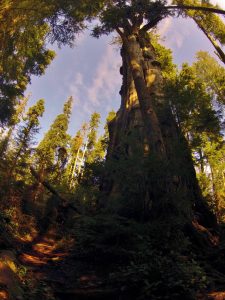For generations, the Quinault Big Cedar on North Shore Road captivated the hearts and imaginations of all who gazed at this wooden giant. Inspiring wonder and joy to countless visitors, this tree was a popular destination in one of America’s most-visited National Parks. Sadly, the mighty cedar met its demise due to natural causes in late July 2016, just two years after the famous Kalaloch Cedar tree fell during a windstorm. Once one of the many jewels of Olympic, the tree now returns to the ground, where it will be the nourishment for future giant trees taking its place.
![]() Fallen giants are nothing new to the Olympic Peninsula. Throughout the rainforests and wilderness of Olympic, the remains of tall trees litter the landscape, giving much needed food to the younger trees struggling to get enough nourishment and sunlight in the rainforest. Using the fallen tree, saplings take root in the downed log, using it as a nurse log to grow strong and tall. The circle of life isn’t limited to animals, and not a single part of the Big Cedar will go to waste. Further generations will return to the region and find another giant standing, having grown from the remains of the once popular Quinault Big Cedar.
Fallen giants are nothing new to the Olympic Peninsula. Throughout the rainforests and wilderness of Olympic, the remains of tall trees litter the landscape, giving much needed food to the younger trees struggling to get enough nourishment and sunlight in the rainforest. Using the fallen tree, saplings take root in the downed log, using it as a nurse log to grow strong and tall. The circle of life isn’t limited to animals, and not a single part of the Big Cedar will go to waste. Further generations will return to the region and find another giant standing, having grown from the remains of the once popular Quinault Big Cedar.

Once standing nearly 174 feet above the fern-covered, muddy forest below, the Quinault Big Cedar finally succumbed to gravity and the elements of the Quinault Rainforest. At 61 feet around, this tree was huge and nearly impossible to capture in a single photograph. Visiting the cedar was highlighted by posing for a picture, climbing inside of it and experiencing the sights, smells and enormity of the forests of the Olympic Peninsula and Olympic National Park. The Quinault Big Cedar was hollowed out and was slowly deteriorating, with signs this towering monster wouldn’t be around much longer. Once it finally fell, many were left wondering what would happen to this popular trail and inspiring destination. Read more here: http://www.graysharbortalk.com/2016/08/05/quinault-big-cedar/